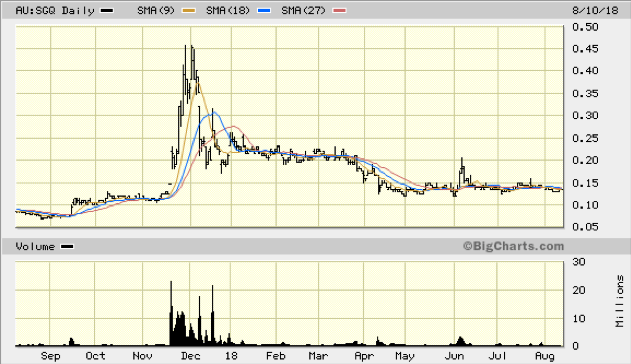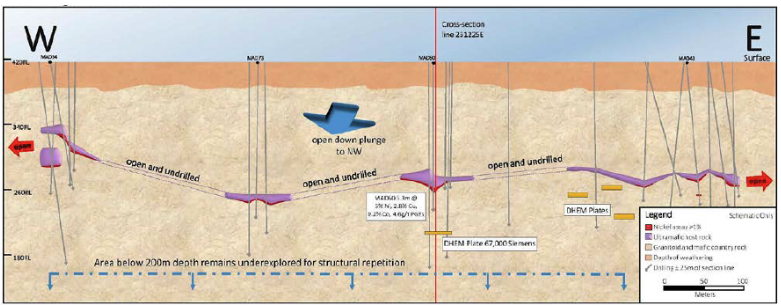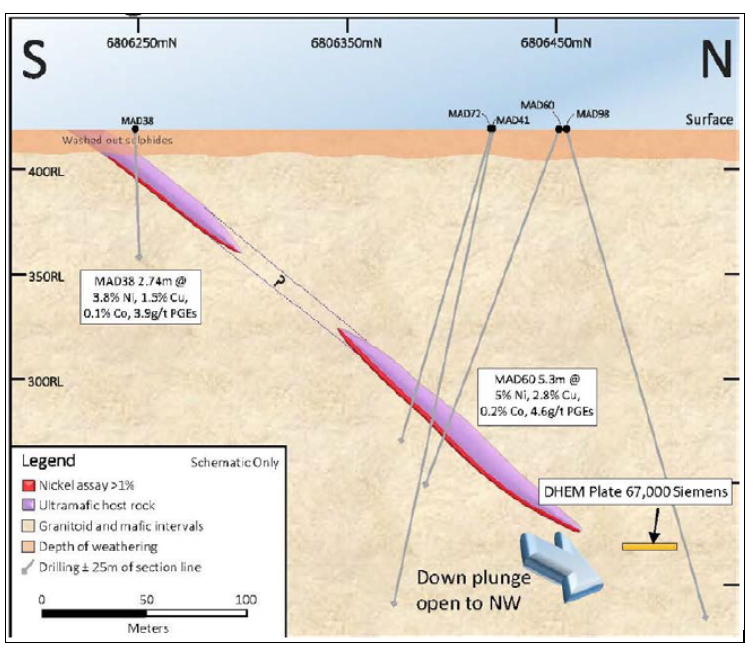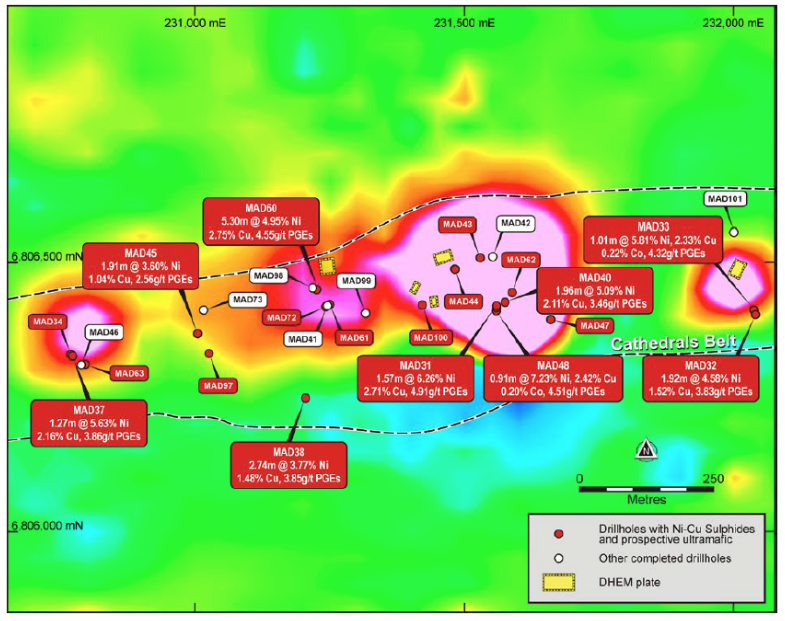St George Mining – (ASX: SGQ, Share Price: $0.135, Market Cap: $40m, coverage initiated @ $0.175 in May 2016)

Key Catalyst
Drilling at Mt Alexander project has recommenced, with an expanded program designed to test five new EM conductors at the Investigators Prospect.
SGQ has figured extensively in our coverage universe over the course of the past two years due to its strong commitment to a regional exploration focus on its Mt Alexander project in WA’s goldfields region. SGQ set the market alight during late 2017 (as can be clearly seen in the share price graphic above), with exciting high-grade drilling results that intersected nickel-copper-cobalt-PGE sulphides – with assays including 17.45m @ 3.01% Ni, 1.31% Cu, 0.13% Co and 1.68g/t Total PGEs from a very shallow depth of 37.45m. These intercepts represent the best exploration results achieved so far from Mt Alexander, with the key aspects being the strong tenor and near-surface nature of the mineralisation – that enhance the commerciality of any prospective mining operation.
Encouragingly, the latest drill program at Mt Alexander has just commenced, with the potential to confirm significant depth extensions to the existing mineralisation.
Latest Activity
Mt Alexander Exploration Update
I recently had the opportunity to meet with SGQ MD, John Prineas, where he provided a comprehensive overview of the company’s upcoming exploration program. The recently commenced drilling campaign at the company’s Mt Alexander Project, located near Leonora in Western Australia’s north-eastern Goldfields, has been expanded and is firmly underway. Importantly, SGQ is well funded, with just under $6m currently in cash reserves to finance its exploration campaign.
Investigators
The first phase of the current drill program is focused on testing five new electromagnetic (EM) conductors identified at the Investigators Prospect from down-hole EM (DHEM) surveys in recently completed drill-holes.
The first EM conductor to be drilled will be MAD98: X1, which is a very exciting prospect as it’s been modelled with a very strong conductivity of 67,000 Siemens, combined with the fact that it’s situated down-dip from the significant intersection in MAD60 (assays of 3m @ 6.40% Ni, 3.55% Cu, 0.21% Co and 5.25g/t total PGEs from 159.38m).
SGQ regards this conductor as an outstanding target for massive nickel-copper sulphides, with the potential to significantly extend the down-dip extent of nickel-copper sulphide mineralisation on the MAD60 section to a strike of about 320m.

Figure 1: Schematic long section of the Investigators Prospect (facing north) based on interpretation from drill-hole data. Drill-holes shown near the DHEM Plate 67,000 Siemens are to the south of the Plate and have not intersected the conductor.
The graphic above represents a long-section view of Investigators that highlights the mineralised ultramafic intersected to date over a part of Investigators with a 1,000m strike, with the EM conductors to be drilled also highlighted.
The graphic below is a schematic cross section of the MAD60 line at Investigators and shows that mineralisation potentially extends down-plunge to the northwest. The very strong EM conductor MAD98:X1 is located within this high-priority target area.

Figure 2: Schematic cross section of the MAD60 line (facing west) at Investigators based on interpretation of drill-hole data. The mineralised ultramafic dips to the northwest, with potential for a down-plunge extension, where the new DHEM conductor is located (MAD98 is off the MAD60 line, and to the west of the target conductor).
Technical Significance
As mentioned earlier, the initial focus of the current program will involve the testing of four new EM conductors at the Investigators Prospect, of which the highlights is MAD98: X1. It’s a very exciting prospect – as it’s been modelled with a very strong conductivity of 67,000 Siemens, combined with the fact that it’s located down-dip from the significant intersection in MAD60.
The drilling of conductor MAD98: X1 will target similar high-grade mineralisation and could confirm the down-dip extent of mineralisation on the MAD60 section to about 320m.
The graphic below is a plan view map of Investigators and shows the surface projection of the modelled plates for the untested EM conductors. The map is set against a large surface SAMSON EM signature and also shows the multiple intersections of nickel-copper sulphides already achieved across the 1.5km strike of Investigators.

Figure 3: Plan view of Investigators Prospect, with drill-hole collar locations over the large SAMSON total field EM anomalies (red/pink colours). SAMSON EM image is shown in Channel 18 (44ms). The surface projection of the untested DHEM plates is also shown.
The drilling of the five new EM conductors has strong potential to identify significant extensions to the known mineralisation at Investigators.
Drilling so far by SGQ within the Cathedrals Belt has identified high-grade nickel-copper-cobalt-PGE sulphides over a strike length of 4.5km.
Summary
The identification so far of thick widths of high-grade mineralisation at shallow depths within the Cathedrals Belt has favourable consequences in terms of a potential mining operation. SGQ has already established recurrent high-grade mineralisation over a 3.5km strike length within the belt. With interest in nickel plays growing, especially those with resource potential, there is the possibility of near-term share price upside, as results filter through. In particular, the drilling of the first EM conductor – MAD98: X1 – will be very keenly watched.







